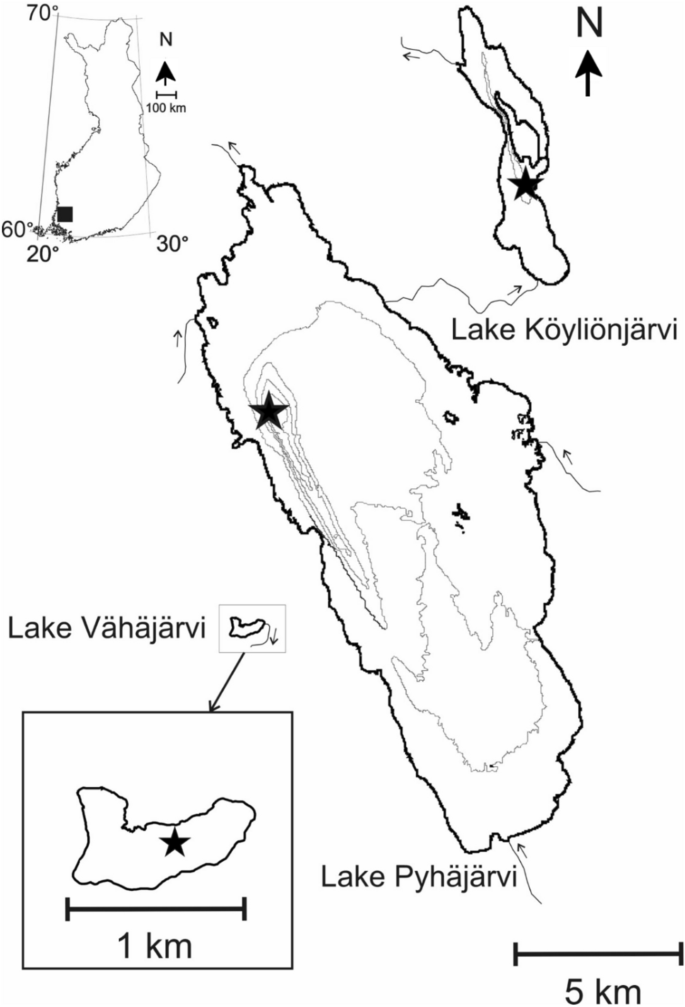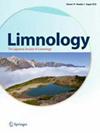Sedimentary phosphorus burial in three contrasting boreal lakes in Finland
IF 1.6
4区 环境科学与生态学
Q3 LIMNOLOGY
引用次数: 0
Abstract
Abstract Permanent phosphorus (P) burial in sediment regulates lake trophic state over long timescales, but the controls on P burial are only partially understood. A diversity of biogeochemical settings may be found in lake sediments, which may have a strong impact on the processes controlling P burial from one location to another. Here, we investigate early diagenesis of P in three contrasting lakes in Southwest Finland. Eutrophic Lake Köyliönjärvi and mesotrophic Lake Pyhäjärvi have a history of nutrient loadings from agriculture, while Lake Vähäjärvi is an oligotrophic small forest lake, leading to potentially contrasting sediment biogeochemical dynamics. We combined porewater data and solid-phase sediment geochemical data to identify P phases in each system and investigate the dominant processes controlling P burial. Porewater profiles showed opposite gradients between the oligotrophic and the mesotrophic/eutrophic systems, implying net diffusive fluxes into and out of the sediments, respectively. Furthermore, sediment P data showed contrasting P speciation. Reactive P is buried in all systems, but the role of reducible iron (Fe) oxides in P retention is greater in mesotrophic/eutrophic lakes. In the oligotrophic system, aluminium (Al) oxides controlled P sorption into the sediment after diffusion from lake water. Evidence for vivianite formation was found only in the mesotrophic Lake Pyhäjärvi sediment, where 42–47% of total P was released in a Fe(II)-P specific extraction from the deeper part of the sediment column and vivianite crystals could be isolated from sediment samples.

沉积磷埋藏在芬兰三个对比鲜明的北方湖泊
沉积物中永久磷(P)埋藏在长时间尺度上调节着湖泊的营养状态,但对P埋藏的控制仅部分了解。湖泊沉积物中生物地球化学环境的多样性可能会对控制P埋藏的过程产生强烈影响。在这里,我们研究了芬兰西南部三个不同湖泊中P的早期成岩作用。富营养化湖Köyliönjärvi和中营养化湖Pyhäjärvi具有农业养分负荷的历史,而Vähäjärvi湖是一个少营养化的小型森林湖泊,导致沉积物生物地球化学动力学的潜在差异。结合孔隙水资料和固相沉积地球化学资料,确定了各体系的P相,探讨了控制P埋藏的主导过程。孔隙水剖面在贫营养系统和中营养/富营养系统之间表现出相反的梯度,分别表明净扩散通量进入和流出沉积物。此外,沉积物P数据显示了不同的P形态。活性磷在所有系统中都有埋藏,但在中营养/富营养化湖泊中,还原性铁氧化物在磷保留中的作用更大。在贫营养系统中,铝(Al)氧化物从湖水中扩散后控制沉积物对磷的吸附。只有在中营养型湖泊Pyhäjärvi沉积物中发现了橄榄石形成的证据,其中42-47%的总磷是在沉积物柱深层的Fe(II)-P特异性提取中释放出来的,并且可以从沉积物样品中分离出橄榄石晶体。
本文章由计算机程序翻译,如有差异,请以英文原文为准。
求助全文
约1分钟内获得全文
求助全文
来源期刊

Limnology
地学-湖沼学
CiteScore
4.30
自引率
6.20%
发文量
15
审稿时长
>12 weeks
期刊介绍:
Limnology is a scientific journal published three times a year, in January, April, and August, by Springer in association with the Japanese Society of Limnology. The editors welcome original scientific contributions on physical, chemical, biological, or related research, including environmental issues, on any aspect of basic, theoretical, or applied limnology that present significant findings for the community of scholars. The journal publishes Rapid communications, Research papers, Review articles, Asia/Oceania reports, and Comments.
The aims and scope of Limnology are to publish scientific and/or technical papers in limnological sciences, to serve as a platform for information dissemination among scientists and practitioners, to enhance international links, and to contribute to the development of limnology.
 求助内容:
求助内容: 应助结果提醒方式:
应助结果提醒方式:


